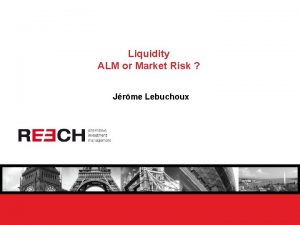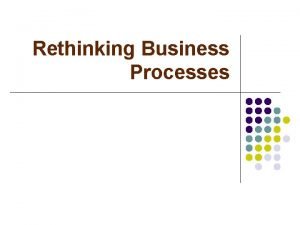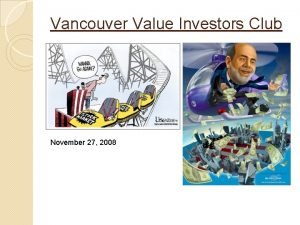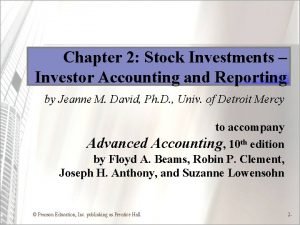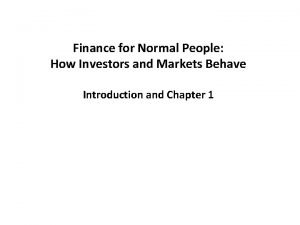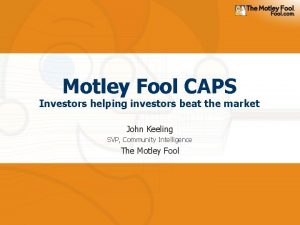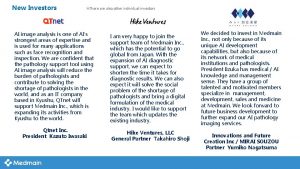Fundamentally rethinking ALM Neil Snyman Aviva Investors Paul







































![Questions Comments The views expressed in this [publication/presentation] are those of invited contributors and Questions Comments The views expressed in this [publication/presentation] are those of invited contributors and](https://slidetodoc.com/presentation_image_h/c976652bb7219ff3b8cf28224424a99d/image-40.jpg)
- Slides: 40

Fundamentally re-thinking ALM Neil Snyman, Aviva Investors Paul Fulcher, Nomura International plc

Team Mailbox: AI_LDI@avivainvestors. com Who we are Insurance UK Life – With Profit / Non Profit Funds UK Life – Annuity Funds Pensions LDI Aviva Group – Treasury, Aviva Re, Mixer ASPS RAC UKGI

How we do it Aviva Economic Capital model 1 in 200 stress Assets managed in a risk constrained absolute return mandate Assets and Liabilities Liability exposure matching portfolio Funding Rate + Spread - Funding Rate + Spread 3

What we hear when we discuss insurance investment… 4

The ideal: Risk Based Capital Constrained Portfolio Management - Clear investment objective driving investment strategy - Focus on economic value not accounting profits - Risk appetite clearly expressed - Clear governance within set risk limits - Transparent view of risk and relevant performance 5

Jargon Buster • Funding • Liquidity • Capital • RWA • Leverage • Spread “Give me a lever long enough and a place to stand I will move the entire earth”, Archimedes 6

po pe Th nso rtis ou rs e h Pr ght ip og le C res ade om s rs hi Se mu p n ss it y Ed ion uc al M W at e or ion eti ki ng n Vo g s lu pa n R tee rtie es ri s ng e a Sh r ap ch N ing et w the Pr or of kin futu es g re En si te ona Le rpri l s ar se up O ned an por d pp t s r or oc is In tun ie k te t rn ity y Jo ati ur on Su nal al p ro pp s fil o e A step back: The competitive landscape

Pressure on banks Volcker rule Ring-fencing Liquidity coverage ratio Net stable funding ratio MIFID Central clearing FTT Central clearing OTC reforms / margin Short-selling Basel III market risk Leverage ratio Net stable funding ratio Balance sheet levy Source: CGFS Paper No 52 “Market making and proprietary trading: industry trends, drivers and policy implications” 8

Implications Reduced leverage Falling inventory “Although liquidity may on average be higher, the risk that liquidity may not be available when it is needed most has also risen. ” Source: CGFS Paper No 52 “Market making and proprietary trading: industry trends, drivers and policy implications” Bank of England Deputy Governor speech, Dealing with change: Liquidity in evolving market structures, Oct 2015 9

Knock-on effect for hedge-funds IRR 10% Strategy return 6 * leverage L+150 Cost L+25 IRR 5. 5% Strategy Return 6 * leverage L+150 Cost L+100 Source: Barclays, “Evolution of the Hedge Fund Financing Model”, September 2012 http: //www. risk. net/risk-magazine/feature/2349066/hedge-funds-to-be-hit-by-prime-broker-charges-under-basel-iii http: //www. risk. net/risk-magazine/feature/2361104/no-arbitrage-new-rules-make-markets-less-efficient 10

Private equity – loan-on-loan finance Purchased at large discount Returns through restructure and onward sale Equity (35%) Nonperforming loans L+[700] Loan-onloan 65% L+350 Source: Cushman and Wakefield “European Real Estate Lending Market” February 2015 IRR = 15% (L+1350) 5 year loan vs. longer dated loans Refinancing risk 11

So who can fill the gap Liability profile less sensitive to changes in liquidity conditions. ongoing accounting and regulatory changes higher risk charges may disincentivise allocations to corporate bonds. Solvency II Exposure to volatility Source: CGFS Paper No 52 “Market making and proprietary trading: industry trends, drivers and policy implications” 12

po pe Th nso rtis ou rs e h Pr ght ip og le C res ade om s rs hi Se mu p n ss it y Ed ion uc al M W at e or ion eti ki ng n Vo g s lu pa n R tee rtie es ri s ng e a Sh r ap ch N ing et w the Pr or of kin futu es g re En si te ona Le rpri l s ar se up O ned an por d pp t s r or oc is In tun ie k te t rn ity y Jo ati ur on Su nal al p ro pp s fil o e The opportunity for insurers

Allocating the cost of funding Insurance liabilities Liability benchmark portfolio Investment portfolio “Risk-free” – X Underwriting profit Risk-free rate Libor - CRA “Risk-free” + spread / excess return Liquidity needs and duration profile Basis risk vs. liability discounting Return vs. marginal capital 14

Insurance vs. market risk Excess return (spread) 25 bpa Diversified 5. 0% 13. 6% RB C Stand-alone re ga te Ri sk 11. 8% Ag g 10% Insurance Risk RBC Return on marginal capital 15% correlation BC R k s t Ri ke Mar 5% 15

But what about the Volatility Adjustment? Source: “Damp Squid, the English Language laid bare”, Jeremy Butterfield 16

But what about the Matching Adjustment? 17

Examples … “Float” Funding @ 2. 2% (T-bills - 3%) Leverage 1. 6 -1 1965 -2014 Information ratio 0. 66 Berkshire Hath. S&P 500 Book value Market value Total return 19. 4% p. a. 21. 6% p. a. 9. 9% p. a. 751, 113% 1, 826, 163% 11, 196% Source: Berkshire Hathaway Inc. Shareholder Letter 2014, Buffett’s Alpha by Frazzini, Kabiller, and Pedersen (2013), NBER Working Paper 18

Examples … “Attractive cost of funding allows us to be patient, disciplined and opportunistic in our investment philosophy – our asset allocation is driven by market opportunity… … capturing incremental spread by assuming incremental liquidity and complexity risk rather than credit risk” Return on equity illustration Assets $1, 500 Reserves $1, 400 Capital [7%] (14 * leverage) Liabilities $100 $1, 500 Income statement Investment income [6%] $90 (Cost of reserves [3. 5%]) ($49) Spread income Overheads & taxes [1. 5%] $41 ($21) Operating income $20 Return on equity 20% Source: Athene Holdings, High‐Level Business Model Overview – Investor Presentation, 2013 and Investor Day October 2015 19

Examples … Source: Fosun International 2014 Annual Results Presentation 20

po pe Th nso rtis ou rs e h Pr ght ip og le C res ade om s rs hi Se mu p n ss it y Ed ion uc al M W at e or ion eti ki ng n Vo g s lu pa n R tee rtie es ri s ng e a Sh r ap ch N ing et w the Pr or of kin futu es g re En si te ona Le rpri l s ar se up O ned an por d pp t s r or oc is In tun ie k te t rn ity y Jo ati ur on Su nal al p ro pp s fil o e Risk Based Capital Constrained Portfolio Management

Background Where structural premiums originate • Not all investors are in an equal position! • Rationale for structural investor specific advantages are: 1. Illiquidity - It is difficult to trade out of the positions during life of the transaction. 2. Complexity - Trades require significant structuring expertise and due diligence, which must be compensated. 3. Cost of funding - Funding cost of participants active in the market may be larger than for insurer 4. Regulatory - Regulatory constraints can increase cost of consuming risk for aggregate participant, often via mismatches between economic and regulatory capital requirements 5. Size – Some illiquid trades come in large sizes and are typically accessible only to large institutional investors 22

How liabilities enter the picture Liability cashflows x (swap implied) discount factors • The present value of a liability is the projected cashflows discounted at the relevant discount rate • For the economic basis this discount rate is implied from the interest rate swap market • Therefore there is market risk embedded in liabilities as changes in swap rates result in changes in liability 23

How we manage liability risk • Liability value is calibrated to market instruments (IRS + potentially others) • Can construct a portfolio of swaps that offsets any change in market value of the liabilities due to market movements • Will need to receive the fixed rate on the swaps to match the fixed liability payments – leaves us with a floating rate payment • Floating rate is 6 month LIBOR – this is the effective liability funding rate • The market risk exposure of the liabilities have been matched by a portfolio of assets and we have to make regular LIBOR-linked payments IR sensitivity from liabs IR sensitivity from swaps Insurance Company 6 month LIBOR 24

What that means for the assets • Investment objective is to invest in assets to meet the liability funding rate of LIBOR • Return in excess of this will add to the surplus • Need to be aware of and able to manage the risk taken to earn this target • Effectively a risk constrained absolute return investment objective Insurance Company Liabilities Assets Risk Constrained Absolute Return Assets Liability Exposure Matching Swaps Liabilities 25

Risk Constrained Assets Focusing on the risk/required capital constrained assets. The investment objective becomes one of allocating risk/capital budget to assets that are expected to offer excess returns for their given risk Property Dependent on liquidity surplus Multi-strategy diversified growth funds Low volatility return generation. . . Risk Constrained Absolute Return Portfolio Fixed Income This is what we will focus on for the rest of the presentation 26

Analysing Fixed Income Returns Spread is excess return over the liability valuation rate but need to hold RBC for risk of this widening Bond yield can be decomposed into Interest Rate and Spread Yield Spread can be further broken down Illiquidity is common explanation but is misleading for excess spread. Mostly compensation for spread volatility Excess Spread risk that spread widens Default Rates IR matches against the IR exposure embedded in liability valuation via valuation rate Rates Allocate risk capital to assets that you judge to offer good excess returns for given Risk Based Capital you will be required to provision 27

Economic Capital for Spread Risk • Credit spread volatility curve is downward sloping • Viewed in market value terms the RBC required increases with longer maturity and lower credit rating 28

Using Derivatives • Derivatives are a useful tool for risk management • Fixed income securities contain various risks: o o credit risk interest rate risk exchange rate risk (if denominated in a foreign currency) inflation risk (if payments are linked to inflation) • Derivatives allow you to manage these risks and isolate the credit risk. This is where we want to spend our risk based capital, allowing us to take the risks we want to with the aim of earning returns in excess of our target rate. Bond Credit Risk Interest Rate Risk FX Risk Inflation Risk Bond + Derivatives Credit Risk 29

Break-even target asset return • We have shown that the liability value grows at LIBOR (less CRA) o Leaving LIBOR as the asset target return to keep up with the liabilities • We also need to consider the market risk of the assets o And the RBC we need to provision for this risk o This capital that has been provisioned needs to be remunerated • This leads to target return over a time horizon to meet the liabilities and remunerate the capital provisioned for market risk Breakeven return = LIBOR + RBC x Co. C x diversification Required return Liab rate Capital Remuneration Returns in excess of this breakeven rate add economic value as it delivers asset value gains over and above what is required to meet the liability and the cost of capital for the risk taken 30

How does MA affect the framework • Liabilities are valued relative to invested portfolio of liability cashflow replicating assets o allowing for defaults • Risk Based Capital is dampened o as some of widening in credit spread shock scenario is matched by higher liability valuation rate, and o the matching adjustment allows expected spread income to be capitalised • The hold to maturity requirement of the assets drives an equivalent time horizon on balance sheet impact Breakeven return = LIBOR + Exp Def +(RBC x dampener – MA) x Co. C x diversification = LIBOR + Exp Def + [RBC x dampener – dur x (spread – FS)] x Co. C x diversification Dampened RBC MA benefit Reduces required return 31

Impact on break-even target 3. 0% 2. 5% 2. 0% 1. 5% 1. 0% 0. 5% 0. 0% 0 5 10 15 20 25 BE non-MA AA BE non-MA BBB BE MA Fin AA BE MA Fin BBB 30 32

Considerations - Portfolio Composition Given the investment objective to maximise return relative to economic risk (or return for an amount of Risk Based Capital) what needs to be considered when composing a portfolio? Some caveats: - Actual returns are retrospective - Expected returns are prospective and subjective - Neither are the same thing as yields or spreads - But yields/spreads are useful for illustration purposes as it is transparent, objective and simple. Avoids the subjectivity from overlaying investment views 33

Governance and Discretion • Liability exposures to be matched can be communicated in terms of interest rate, inflation and liquidity • Risk appetite made explicit in terms of company aligned metrics such as RBC, counterparty limits, liquidity, etc. • This leaves the manager free to utilise risk budget for opportunities that provide good excess returns • Discretion gives ability take advantage of and benefit from dislocations in the market and relative value opportunities • Transparent risk and performance reporting Liability exposures communicated by client Liability exposures matched by manager Risk limits explicitly set out in investment mandate Manager has discretion to utilise risk budget 34

Example 1 – UK Government Bonds Nominal Spread Govt-Swap Nominal Spot Yield Curves % bps 3. 0 Nominal Spread Govt-Swap 150 1 Y Forward Govt-Swap 2. 5 100 2. 0 50 1. 5 Swap - 1. 0 Gilt 0. 5 (50) - (100) 0 5 10 15 20 25 30 Years 35 40 45 50 - Risk Based Capital increases with credit duration - The spread curves flatten off at the long (high RBC) end - Want to position such that we can maximise return vs risk - Forward credit spread exposures can be more efficient than plain long only 35

Example 2 – Swiss AAA Covered Bonds EUR/CHF FX rate SNB Target Rate • The Swiss National Bank applied a currency floor of the EUR CHF exchange rate to stop the CHF strengthening • In Jan 2015 the Swiss National Bank abandoned the peg and cut its target interest rate to -0. 75% • This unexpected and abrupt move caused market dislocations Source: Bloomberg 36

Example 2 – Swiss AAA Covered Bonds CHF Cross Currency Basis Curve as at 21/10/2014 and at 21/01/2015 • • The white curve shows the spread of a short dated AAA Swiss covered bond The yellow curve shows the spread of a longer-dated 15 year bond from the same issuer • As shown in the graph, the spread of the short-dated bond widened whereas the long-dated bond did not move as much ⇒ its not a credit quality related spread move At the same time the cross currency basis widened significantly • Source: Bloomberg 37

Example 3 – XCCY Relative Value Corporates issue bonds in multiple currencies • Facilitates currency specific funding needs • Increases and diversifies the investor base • Relative funding value Valuations across currencies vary as local investor sentiment and local liquidity conditions amongst other factors change. The underlying credit risk remains the same This provides opportunities to buy in another currency swapped back to liability currency 38

Recap • Investment objective is to target economic value when investing • Target excess returns compared to liability funding rate • Need to provision (and remunerate) capital for market risk taken • Clear risk aligned investment mandates delineates overlapping issues • Matching market exposures of the liabilities with a portfolio of derivatives, we are left with a risk constrained absolute return asset portfolio • Target is to meet liabilities and pay for the capital provisioned (which is itself a function of the assets held) • A bond is a package of risks. Derivatives can isolate these risks and allow better investment outcomes • Insurers have a structural investment advantage in some markets 39
![Questions Comments The views expressed in this publicationpresentation are those of invited contributors and Questions Comments The views expressed in this [publication/presentation] are those of invited contributors and](https://slidetodoc.com/presentation_image_h/c976652bb7219ff3b8cf28224424a99d/image-40.jpg)
Questions Comments The views expressed in this [publication/presentation] are those of invited contributors and not necessarily those of the IFo. A. The IFo. A do not endorse any of the views stated, nor any claims or representations made in this [publication/presentation] and accept no responsibility or liability to any person for loss or damage suffered as a consequence of their placing reliance upon any view, claim or representation made in this [publication/presentation]. The information and expressions of opinion contained in this publication are not intended to be a comprehensive study, nor to provide actuarial advice or advice of any nature and should not be treated as a substitute for specific advice concerning individual situations. On no account may any part of this [publication/presentation] be reproduced without the written permission of the IFo. A [or authors, in the case of non-IFo. A research]. 40
 Neil snyman
Neil snyman O que significa alm
O que significa alm Aras altium connector
Aras altium connector Competitive intelligence law firm
Competitive intelligence law firm Alm liquidity
Alm liquidity Hp agile manager alm
Hp agile manager alm Alm significado
Alm significado Alm nedir
Alm nedir Customer service wordle
Customer service wordle Alm
Alm Banka hesap planı
Banka hesap planı Alm policy credit union
Alm policy credit union Flawed assumption meaning
Flawed assumption meaning Fundamentally toys
Fundamentally toys Rethinking business process
Rethinking business process Rethinking file mapping for persistent memory
Rethinking file mapping for persistent memory Rethinking engineering education: the cdio approach
Rethinking engineering education: the cdio approach Rethinking teacher supervision and evaluation
Rethinking teacher supervision and evaluation What is the fundamental rethinking of business processes
What is the fundamental rethinking of business processes Rethinking the 4 p's
Rethinking the 4 p's Rethinking file mapping for persistent memory
Rethinking file mapping for persistent memory Rethinking expertise
Rethinking expertise Arxiv
Arxiv Rethinking education: towards a global common good?
Rethinking education: towards a global common good? 2 timoteo 3 10-17 explicacion
2 timoteo 3 10-17 explicacion Betty kowalski
Betty kowalski Aviva hawkeye
Aviva hawkeye David schofield aviva
David schofield aviva Aviva future focus 2 drawdown
Aviva future focus 2 drawdown Savers and investors role in financial markets
Savers and investors role in financial markets Pros and cons of angel investors
Pros and cons of angel investors Monash investors
Monash investors Valueinvestorsclub
Valueinvestorsclub Investors in accounting
Investors in accounting Cvm investors hub
Cvm investors hub Rupertlawgroup.com e2-visa-requirements-investors
Rupertlawgroup.com e2-visa-requirements-investors Normal people chapter 1
Normal people chapter 1 The railroad had primary investors who were known as
The railroad had primary investors who were known as Chapter 6 consumers savers and investors answer key
Chapter 6 consumers savers and investors answer key Roles and importance of institutional investors
Roles and importance of institutional investors Value investing club
Value investing club




